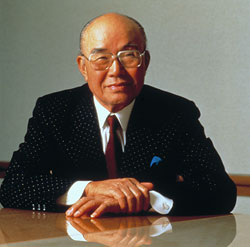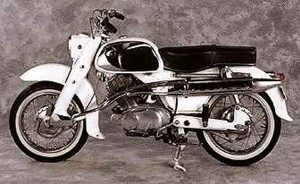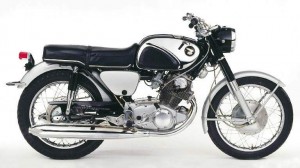Soichiro Honda’s Success Story: How He Created The World’s Most Successful Motorcycle Business
The success story you are about to read ranks among the world’s amazing rags-to-riches stories ever told. It is about how a man, Soichiro Honda by name, with no formal education surmounted all odds to successfully build his business from scratch into a multinational enterprise, leaving huge lessons for today’s small and big business owners alike to draw lessons.
Here it goes:

Soichiro Honda's success story
Born to a blacksmith father, who owned a bicycle repair business on November 17th 1906, Honda grew up in the rural neighborhood of Iwata-gun, helping his father with his business until he was 15. At this age, with no formal education he thought his chance of succeeding in life would be better if he moved to Tokyo to get a job.
And by 1922, young Honda was working as an apprentice car mechanic at a garage in Tokyo, learning all he could about the workings of automobile machines. He was on this work for six years before coming back home in 1928 to set up his automobile repair business.
Eager to put his knowledge and experience of automobile machine repair to work, Honda organized the Tokai Seiki Company Ltd to make piston rings, but the project was not yielding result. And after seven years of trying without success, Honda realized his technical knowledge was not enough, and that he needed to upgrade it, so he got enrolled into a technical school in 1935 with the singular goal to discover why he couldn’t produce piston rings.
With his knowledge enhanced, Honda was finally able to successfully make piston rings, not only for automobiles, but also for motorcycles and airplanes.
In 1948, he observed that the supply of motorcycles or motorbikes as it is also called, was short, and saw a big opportunity to make profit in the business. Quickly, he formed the Honda Motor Company Ltd with 13 employees, housed in a 12 by 18 foot shed in Hamamatsu.
A year later, Honda launched his first motorcycle, which he named Dream D, and two years later he introduced the 1500cc “E†model Dream. The motorcycles were successfully accepted in the market and sales were doing well.

Honda success story: the Honda Dream
Without getting carried away by his success, Honda continued to improve on his motorcycles’ quality and design, and by 1959 Honda was the largest motorcycle manufacturer in the whole world, producing 500, 000 units yearly. With this monumental success, and the belief that a huge market exist globally for his light, fun to ride, and cheap motorcycles, his next plan was to expand his business internationally.
To decide the region to expand to, a survey was carried out and the result advised that the Honda Motor Company should spread their business into Southeast Asian and the European market, rather than the US. The US market was not favored primary because of the very low motorcycle riding culture prevailing at the time, with annual sales of only 60, 000 units as proof.
But instead of heeding the advice to leave out the US market in his expansionist drive, Honda did the exact opposite.
He reasoned that he stood a big chance of succeeding in the US market – his light motorcycles will not be competing directly with the large-displacement models that Americans loved, and that if he could take away the low image Americans had about riding motorcycle, and replace it with a positive one, he would be able to win the hearts of millions of people to buy his motorcycles since the US combine a large population with strong purchasing power. And that he was determined to achieve.
Therefore, bound by their marketing philosophy, which says, “Maintaining an international viewpoint, we are dedicated to supplying products of the highest efficiency, yet at a reasonable price for worldwide customer satisfaction,†the Honda Motor Company entered America market June 4, 1959.
With eight men, including Kihachiro Kawashima, the General Manager and leader of the American operation, a small shop on Pico Boulevard in Los Angeles, and with an operating capital of $250, 000, America Honda Motor Company had come for one kind of customers: people wanting small, light, easy to handle and maintain two-wheeled vehicles.
At first they were taken as jokers by competitors and industry watchers to think Honda motorcycles could succeed in America.
In one meeting, a competitor asked Mr. Kawashima how many motorcycle he thought he would sell, and Mr. Kawashima answered 12, 000. “Well, that’s pretty good number for a year… about 1,000 a month?, the competitor asked again. “No, that’s not what I mean,†Mr. Kawashima replied, “I mean 12, 000 a month.â€
Fired by the passion to establish their business in the US, Honda personnel were everywhere seeking dealers to sell their motorcycles. Though many known dealers they met turned them down, they were not discouraged. And instead of wasting more time trying to convince the established dealership structure to accept them, Honda focused on creating new dealership with sporting goods stores, hobby shops, and hardware stores.
Honda did not immediately strike success in the US. By the end of the year they were able to get only 15 dealers to distribute their motorcycles and pull in sales of 1,732 units, netting $500, 000 in gross income and a net loss of $54, 000 for the company.
However, by the close of 1961, Honda’s US dealership had climbed to 400, due mainly to the superb performance of their newly introduced Hawk range of motorcycles – the CB72 250 Hawk, the CB77 305 Super Hawk, and the CL 72 250 Scrambler.

Honda success story: the 1961 Hawk range - CB77
Honda knew if they continued making only high quality products at reasonable price to their customers, and back it up with excellent service, it would only be a question of time before motorcycle lovers begin shifting to theirs. This belief was spread to their American dealers when Honda addressed them in 1961 in Japan:
“Dealers must give their customers the very best service. Quality and service are like the two wheels of a motorcycle, with one, the vehicle will fail. It’s the same in enterprise. We, the manufacturers and the dealers, have worked together to run our business positively based on the universal truths I have mentioned.
“This is the reason we have been able to draw away from our business rivals. You have the world’s largest market, while Honda is the world’s Number One motorcycle manufacturer. If we combine the biggest market and the excellent Honda products – like the two wheels of the motorcycle – then we can easily develop ourselves to the utmost business in the world.â€
And proving Honda Motor Company actually walk their talk, three Honda 50cc motorcycles passed a week-long 24hrs per day Maude Trophy endurance test in England in 1962, traveling a distance of about 16, 000 miles.
This feat brought immense popularity and sales to Honda as lots of people began to take them seriously as a manufacturer of quality product. That year, Honda received their first manufacturer’s award in a decade, which they held for eleven years. They moved into truck and automobile business while maintaining a 65% domination of the Japanese motorcycle market.
Though, they had warmed their way into the hearts of many American motorcycle lovers, most Americans still didn’t like riding on motorcycle. This was the next thing Honda was determined to change.
Honda embarked on an advertising campaign to remove the negative perception Americans have about motorcycle by presenting motorcycles as socially acceptable vehicles, and to plant the idea of motorcycling, Honda and fun in non-users’ minds.
The campaign slogan was “You meet the nicest people on a Hondaâ€, and was carried out using general interest magazine advertising. Before long the strategy proved to be a huge success, with a great number of Americans clamoring to have a ride on Honda’s light, easy to ride and maintain, and affordable motorcycle, which also provided fun and exciting to be on.
By 1963, just four years of Honda Motor Company’s arrival in the US, they were importing about 150, 000 Honda motorcycles to the US market, and their staff strength had grown from eight to 150.
The following year, Honda did something incredible. They decided to spend half of their advertising budget for the year in one night – to place two 90-seconds advertisements in the Academy Awards telecast of 1964 – this cost $350, 000.
The reaction the adverts drew was explosive. Like magic, millions of Americans were ordering their own Honda motorcycles. The adverts threw Honda instantly into National lime light, attracting big companies, such as Westinghouse, Coca Cola, RCA, Pepsi Cola, and DuPoint to do joint ads with Honda.
By the close of 1964 American Honda was the clear leader in image direction, marketing and education, and held 62% of the US motorcycle market.
In only five years, Honda had taken over the American market for motorcycles, and had converted millions of Americans into happy motorcycle riders far from what it used to be.
Apart from been the largest motorcycle manufacturer in the world, Honda Motor Company has equally gone ahead to distinguish itself as one of the world’s largest and trusted automobile manufacturers, with every of their products sealed with the unshakeable Honda business philosophy of quality product and excellent service.
Soichiro Honda died on August 5, 1991 at the age of 85, but not before seeing his dream come true; his once a small business in Japan, becoming a global market leader spreading to many countries of the world. His success story does not leave only inspiration for today’s entrepreneurs and business managers, but also great practical lessons to adopt for business success.
How was Honda able to turn his small business into a world class business empire? Discover his business strategies and apply to your business here: Honda’s Business Strategies For Growing His Small Business
………………………………..
Recommended
Put your business on the path to success with a solid plan created with Business Plan Pro Software .
Experts in business and technology, as well as daily users rate this software higher and above others. Click here to see why.
just started selling honda auto’s Mr honda had a philosophy. I want to understand it better. And once i can truly get it i know my sells will sky rocket. I believe this.So i study the products everyday. i didn’t think about targetting my customers. Their is a auto for everyone’s need. Small families large families, singes . I just need to know where they are . Thanks, Calvin